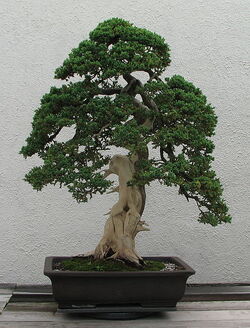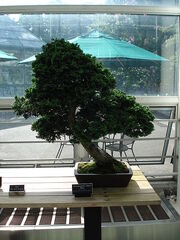There are many different styles that you can utilize when creating your bonsai. Below are some of the most popular styles. The art of Bonsai is tedious so take your time when creating your bonsai. And always remember, you can post questions in the forum.
Formal Upright[]

Formal Upright
The tree has a straight, upright, tapering trunk. Branches progress regularly from the thickest and broadest at the bottom to the finest and shortest at the top. There should be strong surface roots visible, moving from the base ofthe trunk downward into the soil, and radiating evenly around the trunk.
Informal Upright[]

Informal Upright
The trunk and branches are visibly curved. The tip, of the tree is located directly above the trunk's entry into the soil line. Similar to the formal upright style, branches progress regularly from largest at the bottom to smallest at the top, although this progression may be broken at certain irregular spots of the trunk.
Slanting[]

Slant Style
The trunk is straight like that of a bonsai grown in the formal upright style. However, the slant style trunk emerges from the soil at an angle, and the apex of the bonsai will be located to the left or right of the root base.
Cascade[]

Cascade Bonsai
Modeled after trees that grow over water or down the side of a mountain. The apex of a cascade style falls below the base of the pot.
Semi-Cascade[]

Semi-Cascade Bonsai
The apex of the tree extends just at the level of, or beneath, the lip of the bonsai pot.
Multi Trunk Cascade[]
This style applies to any cascade style in which two or more trunks cascade downwards.
Exposed Root[]
The roots of the tree are exposed as extensions of the trunk, free from soil. The roots can extend as far as one-half to two-thirds the total tree height.
Multiple Trunk[]

Multiple Trunk Bonsai
Multiple trunks rise from a single set of roots. One or more trunks are larger and designated as the "dominant trunks." Trunk sizes are varied, with one trunk being the thickest and generally the tallest. The trunks are placed so that a straight line cannot intersect all three, to minimize symmetry and make the design look as natural as possible.
Multiple Tree[]

Multiple Tree Bonsai
The three-tree through nine-tree styles are considered "group settings" rather than forests. The smaller number of trees means that some stylistic goals, such as having no more than two trees in line with each other, may be applied to these bonsai. Trees in groups settings vary in trunk width and height, but generally resemble each other in proportions, density of foliage, and other visual characteristics. In the multiple-tree style, one or two trees will be the dominant ones. The other two will be smaller and usually differ in size from each other.
References[]

|
This page uses content from Wikipedia. The original article was at Bonsai Styles. The list of authors can be seen in the page history. As with Horticulture and Soil Science Wiki, the text of Wikipedia is available under the Creative Commons Licence. |